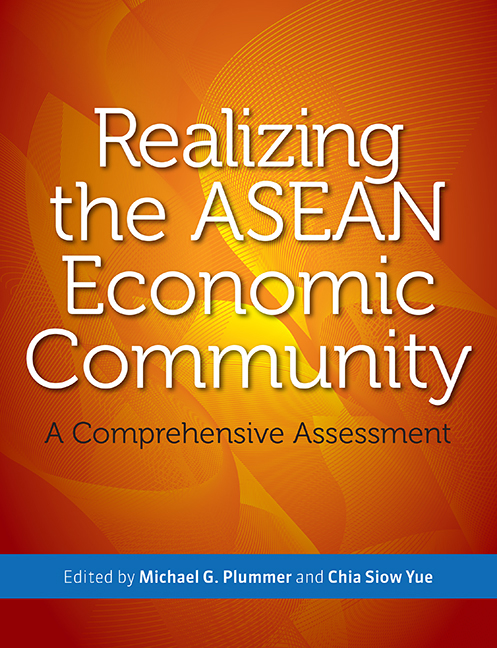Book contents
- Frontmatter
- Contents
- Illustrations
- Foreword
- Executive Summary
- Acknowledgements
- About the Contributors
- 1 Introduction
- 2 Regional Market for Goods, Services, and Skilled Labor
- 3 Competition Policy, Infrastructure, and Intellectual Property Rights
- 4 The AEC and Investment and Capital Flows
- 5 Narrowing the Development Gap in ASEAN
- 6 Competitiveness and Leverage
- 7 Benefits of the AEC
- References
- Appendix A AEC Components
- Appendix B The CGE Model
- Appendix C Developments in Logistics and Aviation
- Appendix D AEC Blueprint Excerpt
- Appendix E ASEAN Free Trade Agreements
- Appendix F ASEAN Member States' Free Trade Agreements
- Appendix G ASEAN Imports and Exports, 2000 and 2006
- Index
Appendix D - AEC Blueprint Excerpt
Published online by Cambridge University Press: 21 October 2015
- Frontmatter
- Contents
- Illustrations
- Foreword
- Executive Summary
- Acknowledgements
- About the Contributors
- 1 Introduction
- 2 Regional Market for Goods, Services, and Skilled Labor
- 3 Competition Policy, Infrastructure, and Intellectual Property Rights
- 4 The AEC and Investment and Capital Flows
- 5 Narrowing the Development Gap in ASEAN
- 6 Competitiveness and Leverage
- 7 Benefits of the AEC
- References
- Appendix A AEC Components
- Appendix B The CGE Model
- Appendix C Developments in Logistics and Aviation
- Appendix D AEC Blueprint Excerpt
- Appendix E ASEAN Free Trade Agreements
- Appendix F ASEAN Member States' Free Trade Agreements
- Appendix G ASEAN Imports and Exports, 2000 and 2006
- Index
Summary
D. INTEGRATION INTO THE GLOBAL ECONOMY
64. ASEAN operates in an increasingly global environment, with interdependent markets and globalised industries. In order to enable ASEAN businesses to compete internationally, to make ASEAN a more dynamic and stronger segment of the global supply chain and to ensure that the internal market remains attractive for foreign investment, it is crucial for ASEAN to look beyond the borders of AEC. External rules and regulations must increasingly be taken into account when developing policies related to AEC.
D1. COHERENT APPROACH TOWARDS EXTERNAL ECONOMIC RELATIONS
65. ASEAN shall work towards maintaining “ASEAN Centrality” in its external economic relations, including, but not limited to, its negotiations for free trade (FTAs) and comprehensive economic partnership (CEPs) agreements. This shall be done by:
Actions:
i. Review FTA/CEP commitments vis-à-vis ASEAN's internal integration commitments; and
ii. Establish a system for enhanced coordination, and possibly arriving at common approaches and/ or positions in ASEAN's external economic relations and in regional and multilateral fora.
D2. ENHANCED PARTICIPATION IN GLOBAL SUPPLY NETWORKS
66. ASEAN shall also enhance participation in global supply networks by:
Actions: i. Continuing the adoption of international best practices and standards in production and distribution, where possible; and
ii. Developing a comprehensive package of technical assistance for the less developed ASEAN Member States to upgrade their industrial capability and productivity to enhance their participation in regional and global integration initiatives.
- Type
- Chapter
- Information
- Realizing the ASEAN Economic CommunityA Comprehensive Assessment, pp. 207Publisher: ISEAS–Yusof Ishak InstitutePrint publication year: 2009

